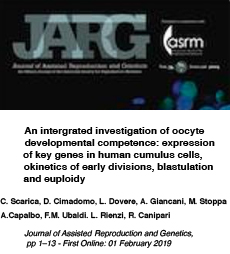
C. Scarica, D. Cimadomo, L. Dovere, A. Giancani, M. Stoppa, A. Capalbo, F. M. Ubaldi, L. Rienzi, R. Canipari
Journal of Assisted Reproduction and Genetics, pp 1–13 – First Online: 01 February 2019
Abstract
PURPOSE: To investigate the association of cumulus cell (CC)-related expression of a selected cluster of key genes (PTGS2, CAMK1D, HAS2, STC1, and EFNB2) with embryo development to blastocyst.
METHODS: Exploratory study at a private clinic. Eighteen advanced maternal age patients were enrolled (37.3 ± 4.0 years). Seventy-five cumuli were collected, whose oocytes resulted in either developmental arrest (N = 33) or blastocyst formation (N = 42). The noninvasive CC gene expression was combined with time-lapse morphokinetic parameters and, for blastocysts, with qPCR-based aneuploidy testing on trophectoderm biopsies.
RESULTS:The detection rate was 100% for all transcripts, but STC1 (96%) and CAMK1D (89%). Among amplified assays, CC mean expression levels of CAMK1D, PTGS2, and HAS2 were higher from oocytes that developed to blastocyst. No difference in CC key gene expression was reported between euploid (N = 21) and aneuploid (N = 21) blastocysts. Some timings of early embryo development were faster in embryos developing to blastocyst (time of pronuclei appearance and fading, division to two- and four-cells, first and second cell cycles). However, the generalized linear models outlined increasing CAMK1D expression levels as the strongest parameter associated with oocytes’ developmental potential from both a general (AUC = 0.78 among amplified samples) and an intrapatient perspectives (AUC = 0.9 among patients obtaining ≥ 2 zygotes from the cohort with different developmental outcomes).
CONCLUSIONS: CAMK1D level of expression in CCs associated with blastocyst development. If confirmed from larger studies in wider populations of patients, the investigation of CC key gene expression might suit IVF clinics not adopting blastocyst culture. Future investigations should clarify the role of CAMK1D in ovarian physiology and could provide novel insights on how oocytes gain competence during folliculogenesis.
KEYWORDS: Blastocysts; CAMK1D; Cumulus cells; Noninvasive embryo selection; Oocyte competence